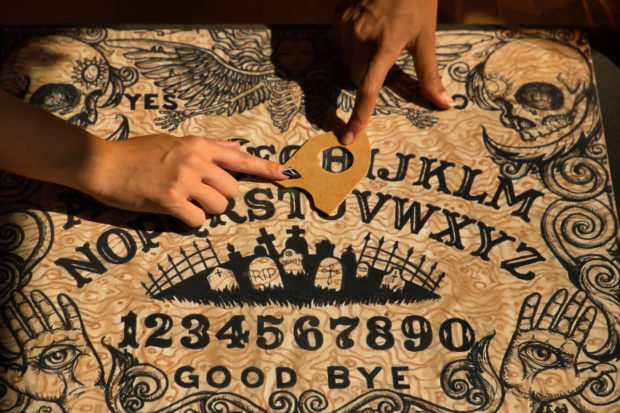Everything You Ever Wanted To Know About The Strange History Of The Mysterious Ouija Board

Every Halloween season, fans of horror and all things freaky whip out their ouija boards in hopes of connecting with the ghostly, paranormal, or simply unknown.
In fact, the board game has become a staple of fall time fun for many and is a popular trope in horror folklore, comics, and movies.
But when was the first ouija board created, and where did the idea come from?
Well, the first advertisement to ever publicize the ouija board people know and love today popped up in local Pittsburgh newspapers in February of 1981.
The ad touted “Ouija, The Wonderful Talking Board” as a supernatural device equipped with the ability to “answer questions about the past, present, and future with marvelous accuracy.”
And shockingly, the first iterations of the ouija board were essentially the same board being sold in chain stores today.
It was a flat board made of wood with two semi-circles spelling out the alphabet and the numbers zero through nine. The board also had the words “yes” and “no” in the upper corners, whereas the word “goodbye” was at the bottom.
Additionally, the teardrop-shaped device ouija board players place their hands on today was also the same. Known as a “planchette,” this tool normally had a small window to display the letter or number below.
In turn, the only real difference is that ouija boards sold today are made of cardboard instead of wood– likely making this one of the least updated games of all time.

Manuel – stock.adobe.com – illustrative purpose only, not the actual person
Sign up for Chip Chick’s newsletter and get stories like this delivered to your inbox.
But, who exactly conceptualized the idea of creating this seemingly magical board is a much more complicated story that is deeply rooted in America’s obsession with spiritualism during the nineteenth century.
Before that, spiritualism– or the belief that the dead can contact and communicate with the living– had been running rampant in Europe for years.
Then, in 1848, America became entranced by the phenomenon. This sudden interest was only exacerbated by the Fox sisters of upstate New York, who claimed to receive messages and answers from spirits by rapping on walls.
This act began to be recreated in parlors throughout the state, and after making national headlines, spiritualism was all the rage.
It also coincided with Christian beliefs and offered a form of solace during an era where the average lifespan of Americans was less than fifty years old. So, knowing that there was some form of presence after death provided comfort to millions.
But, it was not until 1886, when the Associated Press covered the ouija board as a new popular practice among spiritualist camps in Ohio, that a man named Charles Kennard decided to capitalize on it.
Kennard was from Baltimore, Maryland, and, in 1890, he rallied a group of investors to launch the Kennard Novelty Company. And his sole goal was to manufacture and market the up-and-coming “talking boards.”
Unfortunately for some ouija board enthusiasts, though, the men were not spiritual themselves. They simply identified a growing niche and decided to take it to market.
Moreover, the exact origin of the name “ouija” is also not entirely known. Apparently, one of Kennard’s investors– a local attorney named Elijah Bond– got the name from his sister-in-law, Helen Peters.
Helen was reportedly a “strong medium” who had a locket with a picture of a woman and the word “ouija” above her head. Bond asked what it meant and learned that the word apparently meant “good luck,”– which was aptly creepy enough for the board’s purposes.
So, the team went with it. And after that, their last step before launching the famous ouija board was obtaining a patent– which is another wild story.
As an attorney, Bond knew that Kennard would be unable to obtain a patent unless they could prove that the talking board truly worked. So, Bond brought the board to the patent office in Washington and allowed the chief patent officer to use it.
The officer apparently demanded that if the board could accurately spell out his name– which was supposedly unknown to Bond– it would be deemed accurate.
And after they all sat down, the chief patent officer reportedly became “white-faced” once the board accurately spelled out his name. Whether there was truly some spirit present in the patent office that day or if Bond did some prior research before his trip remains unknown.
Nonetheless, the team won its patent on February 10, 1891– and the ouija board’s widespread market success has continued for over one hundred and thirty years now.
The first time the talking board was portrayed in a movie was the 1973 release of The Exorcist. And after that, the horror genre essentially changed forever– with possessions and demons becoming one of the most popular segments of the genre.
Moreover, the board became known as a “tool of the devil” almost overnight. This even prompted its denunciation by religious groups as a means of communicating with satan.
Still, though, one question has remained unanswered– the truth behind how ouija boards really work. But, this spine-tingling puzzle may forever stay a chilling mystery.
If true crime defines your free time, this is for you: join Chip Chick’s True Crime Tribe.
More About:Freaky